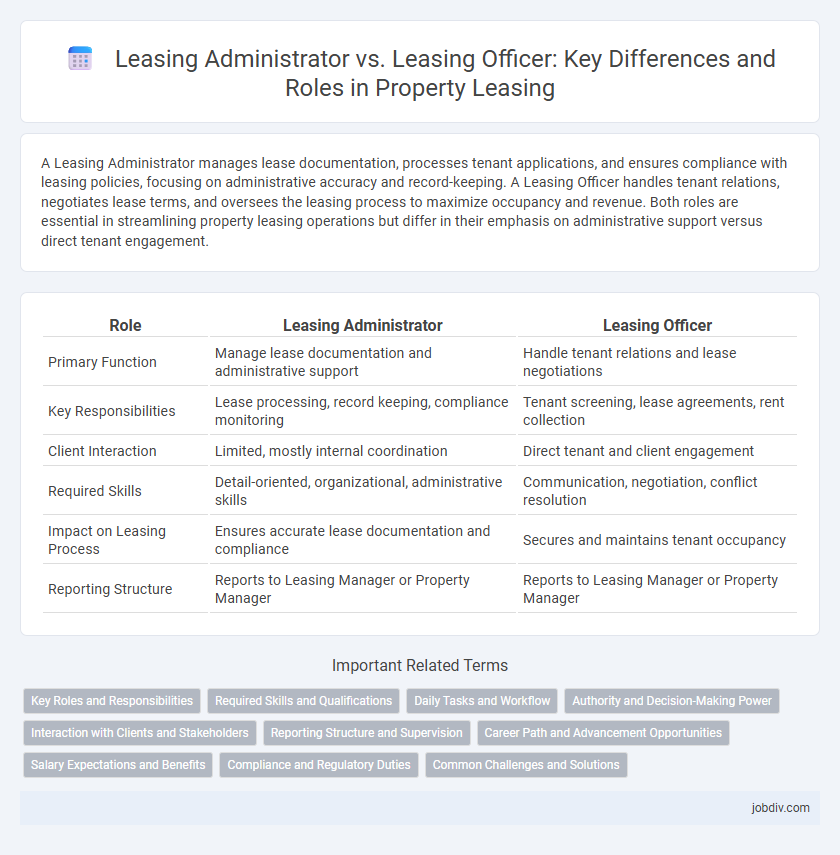A Leasing Administrator manages lease documentation, processes tenant applications, and ensures compliance with leasing policies, focusing on administrative accuracy and record-keeping. A Leasing Officer handles tenant relations, negotiates lease terms, and oversees the leasing process to maximize occupancy and revenue. Both roles are essential in streamlining property leasing operations but differ in their emphasis on administrative support versus direct tenant engagement.
Table of Comparison
| Role | Leasing Administrator | Leasing Officer |
|---|---|---|
| Primary Function | Manage lease documentation and administrative support | Handle tenant relations and lease negotiations |
| Key Responsibilities | Lease processing, record keeping, compliance monitoring | Tenant screening, lease agreements, rent collection |
| Client Interaction | Limited, mostly internal coordination | Direct tenant and client engagement |
| Required Skills | Detail-oriented, organizational, administrative skills | Communication, negotiation, conflict resolution |
| Impact on Leasing Process | Ensures accurate lease documentation and compliance | Secures and maintains tenant occupancy |
| Reporting Structure | Reports to Leasing Manager or Property Manager | Reports to Leasing Manager or Property Manager |
Key Roles and Responsibilities
Leasing Administrators manage lease documentation, maintain accurate records, and coordinate tenant communications to ensure smooth lease operations. Leasing Officers focus on tenant acquisition, lease negotiations, and compliance with leasing policies to drive occupancy and revenue growth. Both roles are essential for efficient property management, with administrators handling operational tasks and officers leading strategic leasing initiatives.
Required Skills and Qualifications
A Leasing Administrator requires strong organizational skills, attention to detail, and proficiency in managing lease documentation, tenant communications, and compliance tracking. A Leasing Officer typically demands excellent negotiation abilities, sales acumen, and knowledge of property leasing laws to secure and manage tenant agreements effectively. Both roles benefit from experience in property management software, customer service skills, and understanding of real estate market trends.
Daily Tasks and Workflow
Leasing Administrators manage lease documentation, process payments, and coordinate tenant communications to ensure smooth contract execution. Leasing Officers focus on property showings, tenant screening, and lease negotiations to secure new renters and maintain occupancy rates. Both roles involve maintaining tenant records and collaborating with property managers to streamline leasing operations.
Authority and Decision-Making Power
A Leasing Officer typically holds greater authority in negotiating lease terms, approving rental agreements, and making binding decisions that impact lease management and tenant relations. In contrast, a Leasing Administrator focuses on administrative support, processing lease documentation, maintaining records, and coordinating communication without final decision-making power. The decision-making hierarchy places the Leasing Officer as the primary executive role responsible for lease approvals, while the Leasing Administrator operates under their guidance to ensure operational accuracy and compliance.
Interaction with Clients and Stakeholders
Leasing Administrators typically manage day-to-day client interactions by handling lease documentation, addressing tenant inquiries, and coordinating maintenance requests to ensure client satisfaction. Leasing Officers engage more strategically with stakeholders, including property owners and potential tenants, by negotiating lease terms and facilitating agreements to maximize occupancy and revenue. Both roles require effective communication skills, but Leasing Officers often lead in stakeholder relationship building to drive leasing success.
Reporting Structure and Supervision
Leasing Administrators typically report to Leasing Managers or Senior Leasing Officers, handling operational tasks such as lease documentation and tenant communications under direct supervision. Leasing Officers hold a more autonomous role, often overseeing Leasing Administrators and coordinating leasing activities while reporting to higher management like the Leasing Director or Property Manager. The supervisory hierarchy positions Leasing Officers as intermediaries between Leasing Administrators and senior leadership, ensuring alignment on leasing strategies and compliance.
Career Path and Advancement Opportunities
Leasing Administrators typically manage lease documentation and coordinate tenant communication, providing foundational skills essential for advancing to roles like Leasing Officer, who handles more complex negotiations and property management responsibilities. Career advancement from Leasing Administrator to Leasing Officer often involves gaining expertise in lease compliance, tenant relations, and financial reporting, which are critical for higher-level decision-making. Progression beyond Leasing Officer roles can lead to Property Manager or Leasing Manager positions, emphasizing leadership, strategic planning, and portfolio management in the real estate leasing sector.
Salary Expectations and Benefits
Leasing Administrators typically earn a median salary of $45,000 to $55,000 annually, with benefits including health insurance, retirement plans, and paid time off, reflecting their role in managing lease documentation and tenant communications. Leasing Officers usually command higher salaries ranging from $55,000 to $70,000 per year, as their responsibilities extend to leasing negotiations, property showings, and contract enforcement, often accompanied by performance bonuses and comprehensive benefits packages. Salary expectations vary by geographic location and company size, with Leasing Officers generally receiving more substantial financial incentives due to their direct impact on leasing revenue and tenant acquisition.
Compliance and Regulatory Duties
Leasing Administrators primarily handle day-to-day compliance by ensuring lease agreements adhere to regulatory standards and internal policies, conducting regular audits, and maintaining accurate documentation. Leasing Officers focus on overseeing broader regulatory duties, including interpreting new legislation, implementing compliance strategies, and coordinating with legal teams to mitigate risks. Both roles require a thorough understanding of local leasing laws, tenant rights, and federal regulations to maintain organizational accountability and avoid legal penalties.
Common Challenges and Solutions
Leasing Administrators and Leasing Officers both face challenges such as managing extensive lease documentation, ensuring compliance with regulations, and maintaining accurate records. Common solutions include implementing advanced lease management software to streamline workflows, conducting regular training on regulatory updates, and establishing clear communication protocols to minimize errors. Leveraging technology and continuous education enhances accuracy and efficiency in leasing operations.
Leasing Administrator vs Leasing Officer Infographic

 jobdiv.com
jobdiv.com